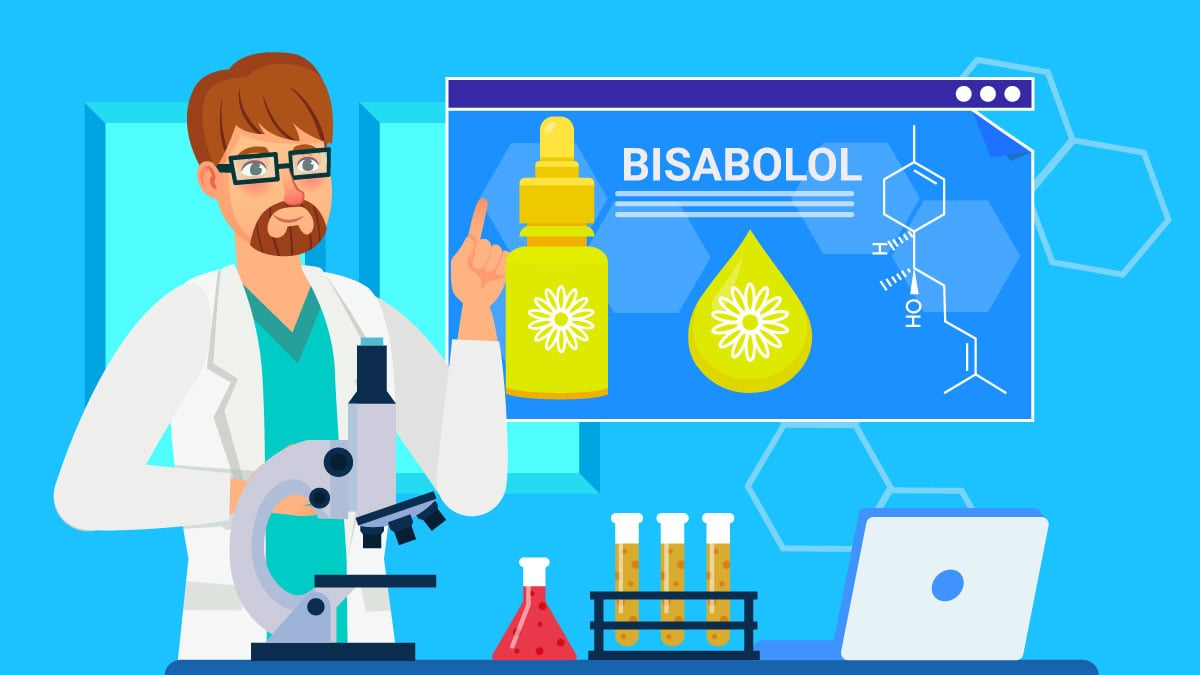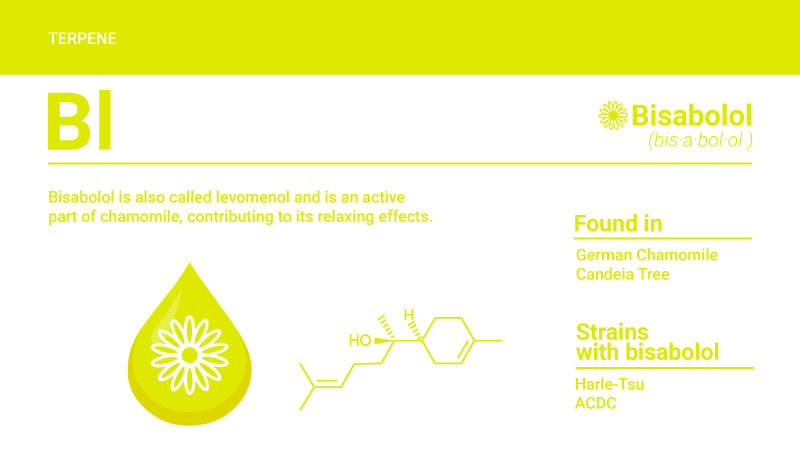Bisabolol Terpene: Usage, Effects & Benefits

Bisabolol, or “levomenol,” is a terpene that is commonly used for its powerful soothing and relaxing properties.
Bisabolol is found in many cannabis plants and is also one of the main components of chamomile essential oil.
This oil is colorless, but it gives off a pleasant, sweet, floral aroma.
What Is Bisabolol?
Bisabolol is a sesquiterpene found in many of your favorite cannabis strains. It can also be found in the candeia tree, which is native to Brazil.
This useful terpene is a popular addition to skincare products, CBD products, THC oils, and much more.
Key Points: Alpha-Bisabolol
- Skin-soothing properties
- Calming agent for sensitive skin
- Potentially offers some degree of discoloration-fading properties
- Simulates gastrointestinal tract receptors resulting in smooth muscle relaxation
- More commonly derived from the chamomile plant, but can also be synthetically created
- Colorless, oily liquid with a floral scent
- Monocyclic sesquiterpene alcohol
- Anti-inflammatory properties
Terpenes are typically used by plants, herbs, and other organisms to either ward off unwanted predators or to attract pollinators.
In the case of bisabolol, since it gives off a sweet, enchanting aroma which is likely produced by flowers to help attract pollinators.
Learn More: What Are Terpenes?
Is Bisabolol Safe?
According to the Food and Drug Administration, bisabolol is considered to be safe.
The FDA says that bisabolol is GRAS, or “Generally Recognized as Safe,” as it currently does not appear to pose any health risks or induce any serious side effects.
Although, speaking with your doctor before using bisabolol isn’t a bad idea. Especially if you have any underlying health conditions or you are taking certain medications. A discussion with a health professional can help you review if bisabolol would be beneficial for your needs.
Learn More: Are Terpenes Safe to Consume?
How to Use Bisabolol
Bisabolol can be used in a variety of different forms, so of the most common being:
1. Cosmetics
Like we mentioned earlier, bisabolol soothes skin and fights inflammation, making it the perfect addition to your skincare routine. It also locks moisture against the skin. It can commonly be found in lotions, face oils, sunscreens, and other facial products.
2. CBD or THC Oils
Bisabolol is a great addition to CBD, THC, or other cannabinoid extracts. It adds a pleasant floral aroma and may work to boost the soothing effects through the entourage effect.
3. Vaping or Smoking
You can find vape products that contain bisabolol, and many cannabis strains like Harle-Tsu, ACDC, and Pink Kush are rich in bisabolol, making it extra easy for you to take advantage of as long as you don’t mind smoking.
4. Aromatherapy
Bisabolol is also very commonly used in aromatherapy. Bisabolol is known for its calming and relaxing effects, which are often enjoyed via chamomile tea. However, those same tranquil, soothing effects can be achieved through aromatherapy while using this terpene.
Learn More: How to Use Pure Terpenes
What Does Bisabolol Smell Like?
Bisabolol offers a sweet, mild, floral aroma similar to chamomile tea.
Just a whiff of this terpene will transport your mind somewhere slower, quieter, and more enjoyable.
Certain cannabis strains also have a strong bisabolol scent. Next time you pick up some Headband, pop it open and smell it, see if you can pick up the chamomile-like bisabolol notes.
What Cannabis Strains Contain Bisabolol?
Herbal teas (chamomile) and relaxing skincare products that contain bisabolol are known to induce a sense of tranquility and relaxation. Likewise, cannabis cultivars with significant levels of bisabolol will provide those same results.
Cannabis strains high in bisabolol:
- Headband
- ACDC
- Pink Kush
- Chocolate Thai
- Sour Candy
- Midnight
- Grape Pie
- Killer Queen
- Hawaiian Haze
- LA Cheese
Bisabolol Chemical Structure
Bisabolol comes in two main forms — alpha-bisabolol (most common) and beta-bisabolol. It’s rare to find the beta version of this molecule in nature.
Alpha-bisabolol is classified as a sesquiterpene, which makes it chemically related to beta-caryophyllene, guaiol, humulene, nerolidol, valencene, and more.
Bisabolol Specs:
- IUPAC Name: (2R)-6-methyl-2-[(1R)-4-methylcyclohex-3-en-1-yl]hept-5-en-2-ol
- Type of terpene: Sesquiterpene
- Molecular Formula:C10H16
- Molecular Weight: 136.23
- Solubility: Practically insoluble in water
Bisabolol Research & Effects
Bisabolol has been known to provide an array of benefits, from physical health to mental health and even skincare.
While individuals have used bisabolol for many years as a valuable health tool, it isn’t approved for medicinal purposes.
1. Bisabolol & Skin Health
Skincare is an area in which this unique floral terpene truly shines.
Here are some of the benefits bisabolol can have on your skin:
- Bisabolol may soothe inflammation in the skin
- Bisabolol may promote faster skin healing
- Bisabolol protects the skin due to its antimicrobial properties
- Bisabolol promotes higher moisture levels in the skin
- Bisabolol offers a natural floral scent
- Bisabolol may resist collagen breakdown in the skin
If you’re looking for a solution to your dry or wrinkled skin, bisabolol may be an ingredient you’ll want to introduce to your skincare routine. Some skincare products already contain this terpene, so keep an eye out for it on labels.
2. Bisabolol as an Antioxidant
One 2016 study revealed that a-bisabolol had a nephroprotective and antioxidant effect in kidney I/R injuries and was also capable of partially protecting the cell lineage against cell damage.
3. Bisabolol & Irritation
A study from 2011 conducted on rodents revealed that a-bisabolol possessed the ability to reduce paw oedemas, decrease leukocyte migration, and lessen mechanical inflammatory hypernociception. Suggesting that bisabolol has powerful anti-inflammatory properties.
Is Bisabolol Psychoactive?
Bisabolol is not psychoactive, but it does induce some relaxing effects.
Most terpenes lack psychoactive effects — with the exception of salvinorin A and myristicin.
When it comes to smell, bisabolol is not as overwhelming as some other terpenes, such as beta-caryophyllene terpene, which gives off a pungent, peppery, spicy scent.
Key Takeaways: What is Bisabolol?
Whether you’re looking for something to manage inflammation, to help you wind down and relax after a long day, or to help your skin glow like it’s never before, a-bisabolol has got your back.
This sweetly-scented terpene seems to offer endless benefits for your skin, as well as antimicrobial and anti-inflammatory properties that could greatly improve your general health.
As time passes, we will only learn more about this valuable terpene and what it has to offer to us.
References Cited
- Russell, K., & Jacob, S. E. (2010). Bisabolol. Dermatitis, 21(1), 57-58



